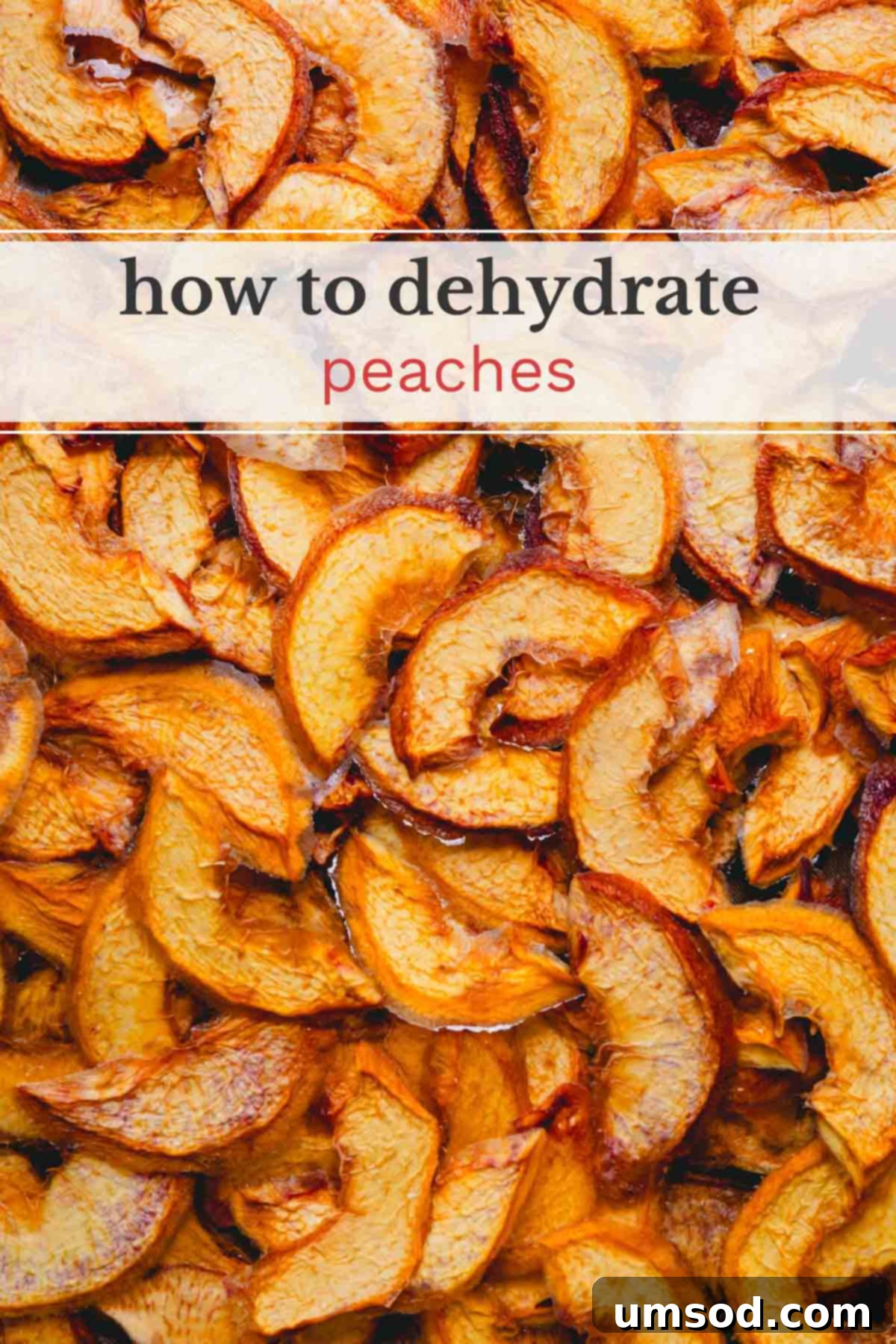The Ultimate Guide to Dehydrating Peaches: Preserve Summer’s Sweetness All Year Round
Unlock the secret to enjoying the sweet, succulent taste of peaches long after summer fades with this ultimate guide to dehydrating peaches. Dehydrating is a remarkably simple and highly effective preservation method, offering a less complex alternative to canning or freezing. This comprehensive tutorial will walk you through every step, ensuring you transform your fresh, ripe peaches into delightful, shelf-stable treats.

Why You’ll Fall in Love with Dehydrated Peaches
Dehydrated peaches aren’t just a way to save your harvest; they’re a culinary delight with numerous benefits that will make them a staple in your pantry. Savor the concentrated flavor of peach season and enjoy a versatile snack that truly satisfies.
- Intensely Delicious & Sweet Snacks: The dehydration process removes water, concentrating the natural sugars and flavors in fresh produce. This results in peaches that are even sweeter and more intensely flavored than their fresh counterparts, offering a chewy texture that’s incredibly satisfying.
- Exceptional Longevity: Properly dried fruit has an impressively long shelf life. Stored correctly, dehydrated peaches can remain fresh and flavorful in your pantry for many months, sometimes even up to a year or more, making them a fantastic preparedness item.
- Effortlessly Simple to Make: Unlike complex canning processes, dehydrating peaches requires minimal hands-on effort. With just one primary ingredient – fresh peaches – and a reliable food dehydrator, the appliance does most of the work for you, freeing up your time while creating delicious results.
- Nutrient-Rich & Wholesome: Dehydrated peaches retain a significant amount of their original vitamins, minerals, and dietary fiber, making them a nutritious whole-food snack. They offer a healthy alternative to processed sweets, providing natural energy without added sugars or preservatives.
- Versatile Culinary Ingredient: While perfect for direct snacking, dried peaches are also incredibly versatile. They can be added to granola, stirred into oatmeal or yogurt, blended into smoothies, incorporated into homemade trail mixes, or even rehydrated for use in baked goods, sauces, and desserts.
- Space-Saving Storage Solution: Dehydration significantly reduces the volume of fruit, allowing you to store a large harvest in a compact space. This is ideal for those with limited pantry or freezer space.
While fresh, juicy peaches are undoubtedly wonderful for making classic desserts like homemade ice cream, comforting cobblers, and delightful upside-down cakes, their dehydrated form opens up a world of convenient and long-lasting culinary possibilities.
Selecting the Best Peaches for Dehydration
The success of your dehydrated peaches begins with choosing the right fruit. You’ll want varieties renowned for their robust, sweet flavor and firm texture, as these attributes hold up best during the drying process. Understanding the characteristics of different peach types can elevate your dehydrating experience.
- Freestone Peaches: These are often considered the gold standard for dehydrating. Their flesh separates easily from the pit, making them incredibly convenient for quick slicing and preparation. Look for varieties like ‘Reliance’, ‘Redhaven’, or ‘Contender’.
- Clingstone Peaches: While the pit is more stubbornly attached to the flesh, clingstone peaches are still an excellent choice for dehydrating due to their exceptionally sweet and juicy nature. If you don’t mind a little extra effort in pitting, their intense flavor is highly rewarding. ‘Early Glo’ and ‘Rich May’ are examples.
- Elberta Peaches: A classic and widely celebrated peach variety, Elberta peaches are treasured for their outstanding, balanced flavor and consistently firm flesh. This combination makes them perfectly suited for dehydration, yielding delicious and chewy dried slices.
- O’Henry Peaches: Known for their appealing blend of sweet and tangy notes, O’Henry peaches also boast a firm flesh that holds its structure wonderfully throughout the drying process, contributing to a superior end product.
- Donut Peaches (Saturn Peaches): These uniquely flattened peaches are fantastic for dehydration. Their naturally sweet taste and lower moisture content, combined with their convenient shape for uniform slicing, make them dry quickly and efficiently into delightful snacks.
When selecting peaches, regardless of variety, look for fruit that is ripe but still firm. They should have a fragrant, sweet aroma and vibrant color without any soft spots, bruises, or signs of mold. Overly soft or underripe peaches will not yield the best results.
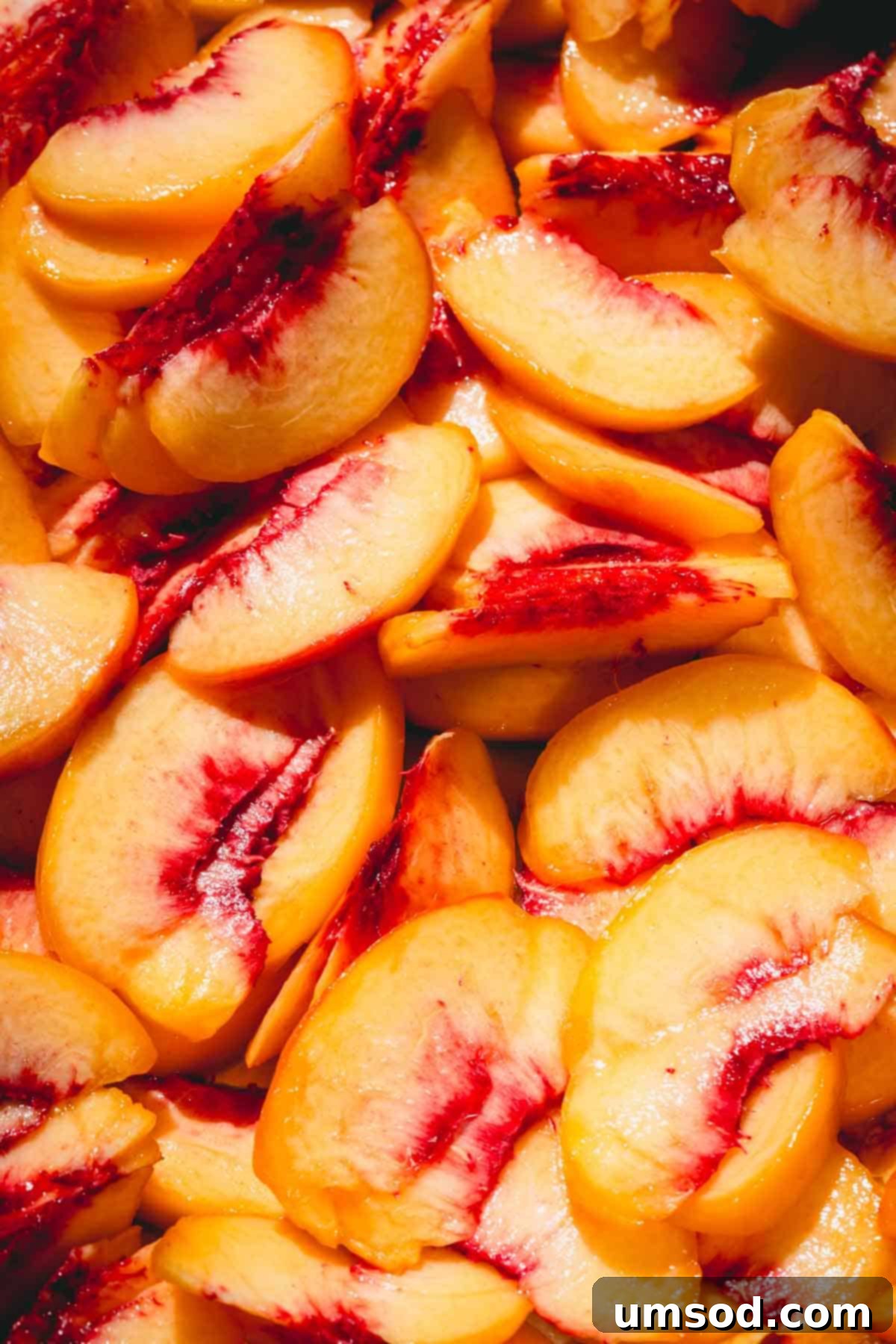
Step-by-Step Guide: How to Dehydrate Peaches for Perfect Results
Dehydrating peaches is a straightforward process that primarily involves preparation and patience. The bulk of the work is done by your dehydrator. Follow these simple steps for perfectly dried peaches every time:
1. Prepare and Peel the Peaches
Peeling peaches might seem like an extra step, but it ensures a smoother texture and enhances the eating experience of your dried fruit. The blanching method is the quickest and easiest way to remove peach skins.
- Boil Water: Bring a large pot of water to a rolling boil on your stovetop. Once boiling, reduce the heat to a gentle simmer.
- Score the Peaches: While the water heats, use a sharp paring knife to carefully cut a large, shallow “X” into the bottom of each peach. This “X” will serve as a starting point for peeling after blanching.
- Blanch: Gently submerge the peaches into the simmering water using a slotted spoon or a heat-resistant strainer. Blanch them for approximately 30-60 seconds. The goal is just long enough for the skin around the “X” to start loosening and curling slightly.
- Ice Bath: Immediately transfer the blanched peaches from the hot water to a large bowl filled with ice water. This “shocking” process stops the cooking and further loosens the skins. Let them cool in the ice bath for 1-2 minutes.
- Peel: Once the peaches are cool enough to comfortably handle, gently pull the skin away from the peach, starting from the “X” you scored. The skin should slip off with minimal effort. Discard the peels.

Avoid Mushy Peaches!
The key to successful blanching is precision. Only blanch the peaches for the shortest time necessary to loosen the peel. Over-blanching will cook the fruit, making them too soft and resulting in a mushy, rather than slightly firm and chewy, dehydrated texture. Timing is everything for that perfect chew!
2. Slice and Arrange the Peaches
Uniform slicing is crucial for even drying, which prevents some pieces from being brittle while others are still moist.
- Halve and Pit: Using your paring knife or a larger kitchen knife, cut each peeled peach in half and carefully remove the pit.
- Slice Uniformly: Cut each peach half into uniform slices, aiming for approximately ¼-inch (about 6mm) thickness. Consistency is key here; thinner slices will dry faster, but too thin might make them brittle. Thicker slices will take longer and might result in a chewier texture, but aim for evenness across all pieces.
- Optional Pre-treatment (Prevent Browning): To help maintain a vibrant color and prevent browning, you can quickly dip the peach slices into an acidic solution. A common method is to mix 1 tablespoon of lemon juice with 2 cups of water. Dip the slices for a minute, then pat them dry before placing them on the dehydrator trays. While optional, this step significantly improves the visual appeal of your dried peaches.
- Arrange on Trays: Arrange the peach slices in a single layer on your dehydrator trays. Ensure there is adequate space between each slice for proper air circulation. Overlapping slices will hinder the drying process and can lead to uneven results. For best results and to prevent sticking, line your dehydrator trays with non-stick Teflon sheets or parchment paper, especially if your trays have large mesh holes.
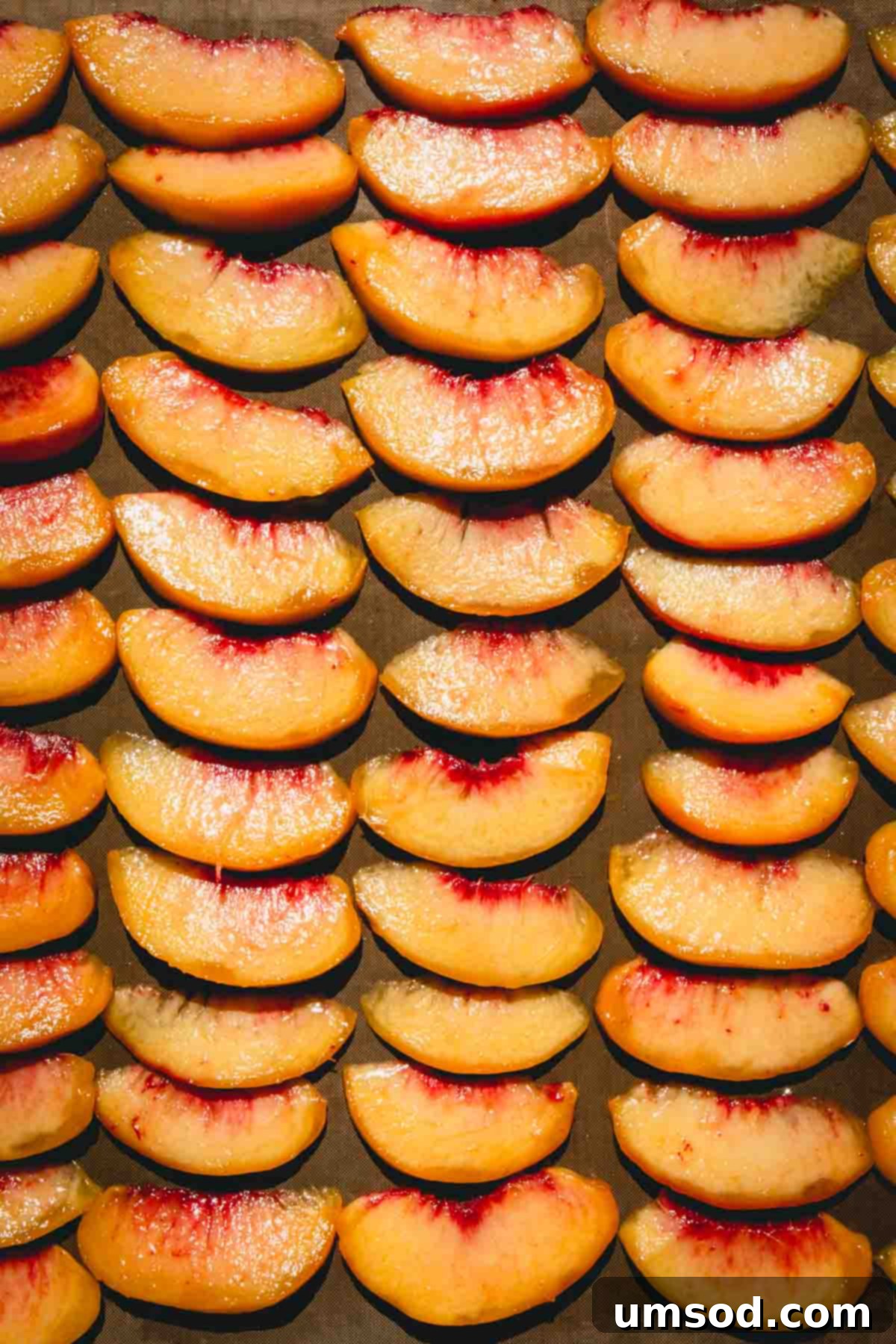
3. Dehydrate and Cool the Peaches
This is where the magic happens, as your dehydrator slowly removes moisture, concentrating the flavors and preserving the fruit.
- Set Dehydrator Temperature: Place the loaded trays into your food dehydrator. Set the temperature to 135°F (60°C). This temperature is ideal for fruits, ensuring efficient drying without “cooking” the peaches.
- Drying Time: Allow the peaches to dry for approximately 14-18 hours. Drying time can vary significantly based on the thickness of your slices, the humidity in your environment, and the specific model of your dehydrator.
- Check for Doneness: Begin checking for doneness after about 12-14 hours. A properly dehydrated peach slice should be pliable and leathery, but not brittle or crispy. When you bend a slice, it should not crack, and no moisture should be visible when pressed. If you tear a piece in half, there should be no visible moisture in the center. If any pieces are still moist, continue drying them, checking periodically.
- Cool Completely: Once fully dried, remove the peach slices from the dehydrator and let them cool completely to room temperature. This is a critical step; warm peaches can release residual moisture when stored, leading to condensation and potential mold growth. Spread them out on a clean counter or cooling rack for an hour or two.
- Conditioning (Optional but Recommended): For optimal storage and to ensure even moisture distribution, you can “condition” your dried peaches. Place the cooled peaches loosely in an airtight container (like a jar) for 7-10 days, shaking the container daily. If any condensation appears, return the peaches to the dehydrator for further drying. This step helps equalize any remaining moisture and prevents spoilage.
- Store: After conditioning (or once thoroughly cooled), transfer your dehydrated peach slices to an airtight container for long-term storage.
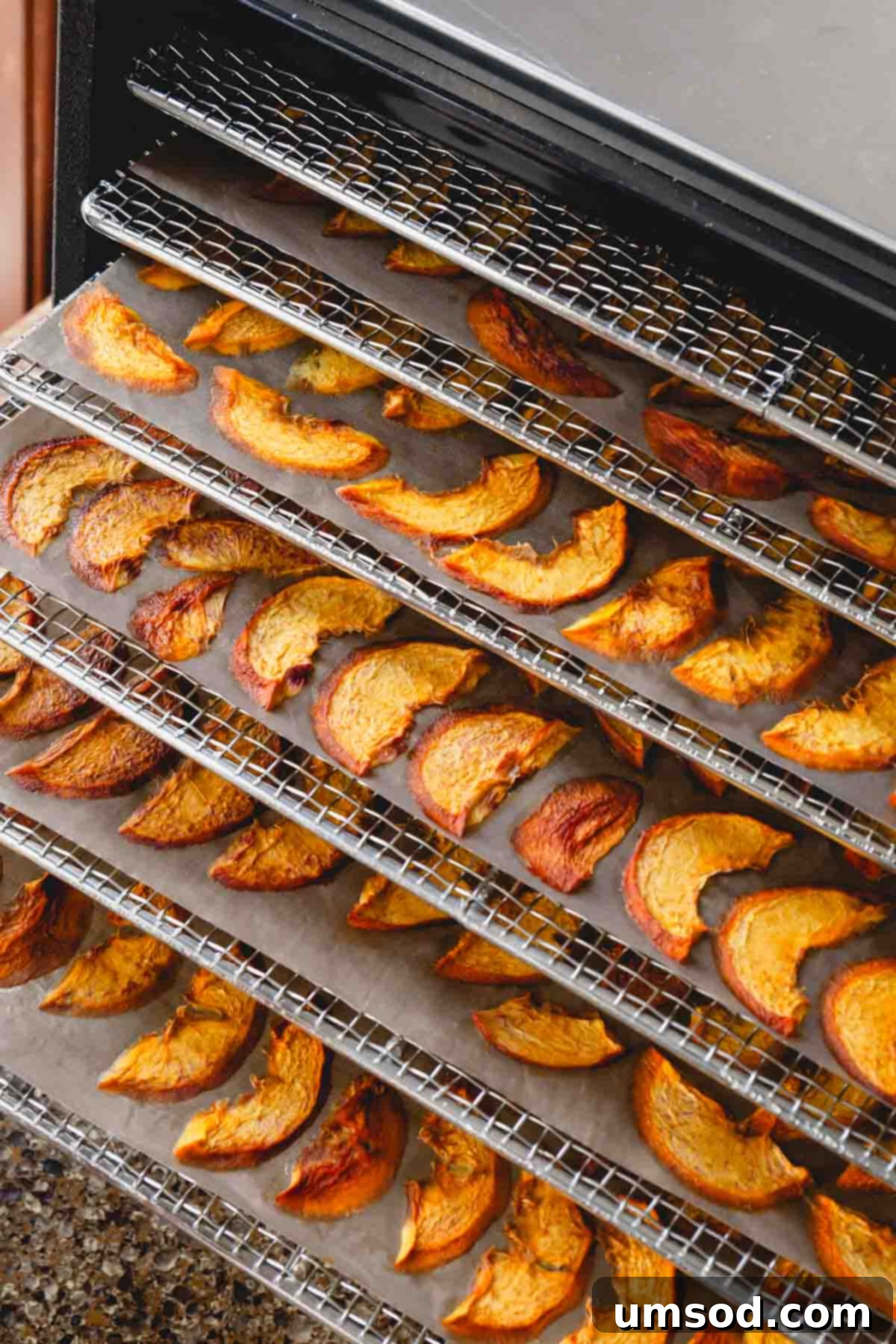

Essential Equipment for Dehydrating Peaches
Teflon Sheets
These non-stick sheets are invaluable for dehydrating sticky fruits like peaches. They prevent the fruit from adhering to your dehydrator trays, making removal effortless and cleanup a breeze. They are also reusable, making them an eco-friendly choice.
Excalibur Dehydrator
A high-quality food dehydrator is the heart of this process. Models like the Excalibur Dehydrator offer consistent heat distribution and ample drying space, which are critical for even and efficient drying. Investing in a good dehydrator can greatly simplify your food preservation efforts.
Pro Tips for Dehydrating Success
- Invest in a Quality Dehydrator: While various models exist, a robust dehydrator like a 9-tray Excalibur Dehydrator is highly recommended. These units offer consistent airflow and temperature control, which are vital for achieving uniformly dried fruit. Many experienced dehydrators vouch for their durability and efficiency over many years of use.
- Choose the Perfect Peaches: Your end product is only as good as your starting ingredient. Select ripe, firm peaches that are bursting with natural fragrance and vibrant colors. Avoid any fruit with soft spots, bruises, or mold, as these imperfections will carry through the drying process and affect quality and shelf life.
- Use Non-Stick Tray Liners: To prevent your delicious peach slices from sticking to the dehydrator racks, especially as they shrink and become more concentrated with sugar, always line the trays. Teflon sheets are ideal for this purpose, making both removal and cleanup significantly easier. Parchment paper cut to size can also work in a pinch.
- Consider a Pre-Treatment: Although optional, a quick dip in an acidic solution (like lemon juice diluted with water) before drying can help prevent the peaches from browning and preserve their attractive golden color. This is purely for aesthetics and doesn’t affect taste or preservation.
- Ensure Uniform Slicing: This cannot be stressed enough. For all peach slices to dry at the same rate and reach the desired pliable texture simultaneously, they must be cut to an even thickness, ideally around ¼-inch. A mandoline slicer can achieve professional uniformity if you’re processing a large batch.
- Learn More About Peaches: For a deeper dive into everything peach-related, consult resources like Peach 101. This type of guide can teach you essential skills like selecting the ripest fruit, optimal storage techniques, and various peeling methods, enhancing your overall peach experience.
Storing Your Dehydrated Peaches for Maximum Freshness
Proper storage is just as important as the drying process itself to ensure your dehydrated peaches remain delicious and safe to eat for an extended period. Follow these tips to maximize their shelf life:
- Cool Completely Before Storing: This is a non-negotiable step. Ensure your dried peaches have cooled completely to room temperature for at least 1-2 hours after removal from the dehydrator. Storing warm peaches can trap residual moisture, leading to condensation inside the container, which is an open invitation for mold and bacterial growth.
- Use Airtight Containers: The primary enemy of dehydrated food is moisture. Always store dried fruit in truly airtight containers to protect them from humidity and air exposure. Glass mason jars with tight-fitting lids are an excellent choice due to their non-porous nature and ability to create a strong seal. Heavy-duty freezer bags or vacuum-seal bags are also effective.
- Choose a Cool, Dark Place: Light and heat can degrade the quality, color, and nutritional value of dried fruit over time. Store your airtight containers in a cool (ideally below 70°F/21°C), dark pantry, cupboard, or cellar. If you reside in a hot, humid climate, or for extended storage, consider keeping your dehydrated peaches in the refrigerator or even the freezer.
- Conditioning is Recommended: As mentioned in the drying steps, conditioning your peaches for a week or so before long-term storage helps ensure all residual moisture is evenly distributed and no pockets of dampness remain. This greatly reduces the risk of spoilage.
- Vacuum Seal for Extended Shelf-Life: For the longest possible storage, consider investing in a vacuum sealer. Vacuum-sealed dried fruit can last for years in optimal conditions, making it an excellent method for preserving large quantities of your harvest.
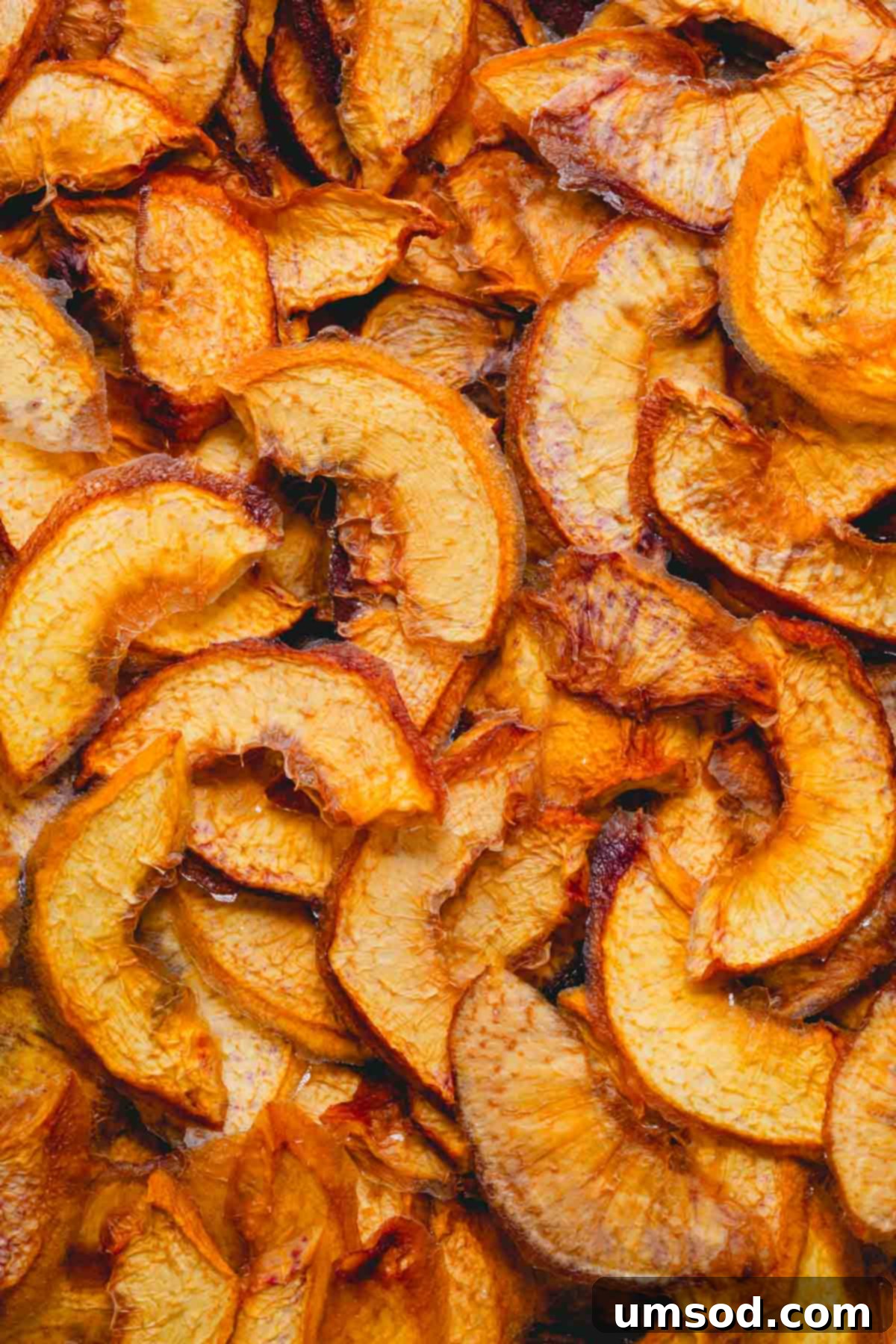
Pin this now to find it later!
Pin It to Pinterest
Frequently Asked Questions (FAQs) About Dehydrating Peaches
Dehydrated peaches are incredibly versatile! They are fantastic as a stand-alone healthy snack, perfect for school lunches or hiking. You can chop them and add them to trail mix, granola, oatmeal, muffins, or cookies. Rehydrate them to use in smoothies, fruit purees, sauces, pies, or as a topping for pancakes and waffles. They also make a great addition to savory dishes like pork or chicken for a touch of sweetness.
To rehydrate dried peaches, simply place them in a bowl and cover them with warm water or another liquid like fruit juice. Allow them to soak for 30 minutes to an hour, or until they regain their desired plumpness. The exact time will depend on how dry they are and your preferred texture. Drain any excess liquid before using.
Absolutely! Dried peaches are a nutritious, whole-food snack packed with vitamins (like Vitamin A and C), minerals (such as potassium), and dietary fiber. The dehydration process concentrates these nutrients. However, because the sugars are also concentrated, dried fruit can be high in natural sugars, so moderation is key, especially if you’re managing sugar intake.
Dehydrated peaches offer a flavor profile similar to fresh peaches but with an intensified sweetness and a more concentrated, sometimes slightly tangy, peach essence. Their texture transforms from juicy and soft to chewy and pliable, often described as leathery. Some describe them as having a richer, almost caramel-like sweetness due to the sugar concentration.
When properly dehydrated and stored in airtight containers in a cool, dark place, dehydrated peaches can last for 6-12 months. If vacuum-sealed or stored in the refrigerator/freezer, their shelf life can extend to 1-2 years or even longer. Always check for signs of spoilage like mold or off-odors before consuming.
Yes, you can dehydrate peaches in an oven, though it requires more vigilance and may not yield results as consistent as a dedicated dehydrator. Set your oven to its lowest possible temperature (usually around 140-170°F or 60-77°C) and prop the oven door slightly ajar to allow moisture to escape. Arrange peach slices on parchment-lined baking sheets in a single layer. The process will take several hours, requiring frequent turning and monitoring to prevent burning. An air fryer with a dehydrate function can also be an option for smaller batches.
More Delicious Peach Recipes to Try
- Refreshing Peach Iced Tea
- Homemade Peach Syrup for Drinks & Desserts
- Warm Spiced Caramelized Peaches
- Creamy Homemade Peach Ice Cream
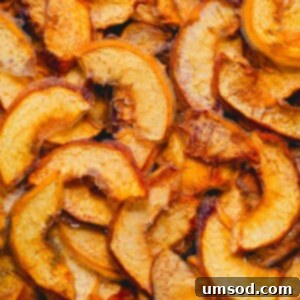
How to Dehydrate Peaches
Learn how to dehydrate fresh peaches with these simple, step-by-step instructions. This guide will help you create perfectly dried peaches, allowing you to enjoy the sweet taste of summer year-round as a healthy snack or versatile ingredient.
Comment
Print Recipe
Ingredients
- Fresh peaches (select ripe, firm, and flavorful varieties like Freestone, Elberta, O’Henry, or Donut peaches)
- Optional: 1 tbsp lemon juice + 2 cups water (for pre-treatment to prevent browning)
Equipment
- 1 food dehydrator (e.g., Excalibur Dehydrator)
- 1-10 Teflon sheets or parchment paper for lining trays
- Large pot for boiling water
- Large bowl for ice water
- Sharp paring knife
- Slotted spoon or spider skimmer
Instructions
To peel the peaches:
- Bring a large pot of water to a boil, then reduce the heat to a gentle simmer. Prepare a large bowl of ice water nearby.
- Using a sharp paring knife, carefully cut a large but shallow “X” into the bottom of each peach.
- Gently submerge the peaches into the simmering water using a slotted spoon. Blanch for approximately 30-60 seconds, or just until the skin around the “X” begins to loosen.
- Immediately transfer the blanched peaches to the large bowl of ice water to stop the cooking process and further loosen the peels. (TIP: Do not blanch peaches for too long, as they will become mushy. You only need enough time for the peel to loosen.)
- Once cool enough to handle, gently pull the skin away from the peach starting from the “X”. The skin should come off easily. Discard peels.
To prepare and dehydrate the peaches:
- Using a paring knife, cut the peeled peaches in half and carefully remove the pit.
- Cut each peach half into thin slices, aiming for a uniform thickness of about ¼-inch. Consistency in thickness ensures even drying.
- Optional: For aesthetic purposes, dip peach slices briefly (about 1 minute) into a solution of 1 tbsp lemon juice mixed with 2 cups of water. Pat dry before arranging.
- Arrange the peach slices in a single layer on your dehydrator trays, ensuring no pieces are overlapping. Line trays with Teflon sheets or parchment paper to prevent sticking.
- Set the dehydrator temperature to 135°F (60°C). Allow the peaches to dry for approximately 12-18 hours. Drying time varies based on peach moisture content, slice thickness, environmental humidity, and dehydrator model.
- Begin checking for doneness after 12 hours. Peaches are fully dry when they are pliable and leathery but not sticky, brittle, or moist when bent or torn.
- Once fully dehydrated, remove the peach slices from the dehydrator and let them cool completely to room temperature (1-2 hours) before storing.
- For optimal long-term storage, condition the cooled peaches by placing them loosely in an airtight container for 7-10 days, shaking daily. If any condensation appears, return them to the dehydrator for further drying.
- Store conditioned and completely cooled peach slices in an airtight container in a cool, dark place for up to 1 year, or vacuum-seal for even longer preservation.
⭐️ Did you make this recipe?
Please leave a review and let us know how you liked it!
Tips & Notes
Note 1: Choosing Peaches for Dehydrating: For the best results, select peach varieties known for their sweet flavor and firm texture. Some excellent choices include:
- Freestone Peaches: Ideal for easy pit removal and slicing.
- Clingstone Peaches: Offer intense sweetness, though pitting requires more effort.
- Elberta Peaches: A classic for their superb flavor and firm consistency.
- O’Henry Peaches: Known for their sweet-tangy taste and firm flesh.
- Donut Peaches (Saturn Peaches): Their flat shape and low moisture make them excellent for quick, even drying.
Storing Tips:
- Allow dehydrated peaches to cool completely to prevent moisture buildup and mold.
- Transfer the peaches to an airtight container (e.g., mason jars) to protect them from humidity.
- Store in a cool, dry, dark place for optimal freshness, typically up to 1 year.
- For extended preservation, vacuum seal the peaches; they can last for years this way.
- Consider refrigerating or freezing in humid climates for added protection.
